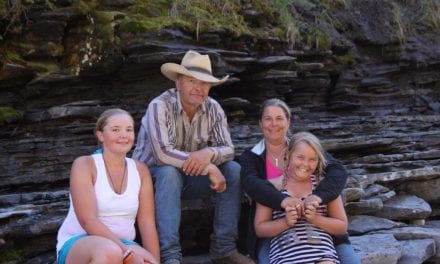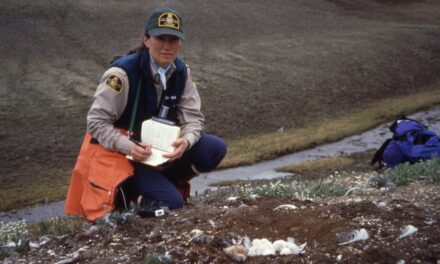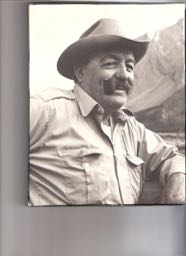(0:21:15) There was another nice incident. Dale Portman and I were up the Moosehorn. We were going up this little draw on the boundary. I happened to look back at Dale to see how he was doing. “Hey Dale, look over your right shoulder.” He turned around and there was one of the loveliest grizzlies that I think that we have ever seen, sitting up by a stump there. Yep, (the bear was just watching them). We went right by him.
(0:21:59) At the Moosehorn again, at that same cabin I had Mony and Karen, two of my kids out there on a little two or three day trip. I was getting ready to hobble the horses and put them out for grazing. I looked across the creek and I could hear this racket. This snapping of twigs and I thought “What the heck?” Out of the bush came this cow moose and a calf right behind her and a big black wolf behind them! They ran through a bunch of brush along the creek. She came out one end, no calf and the wolf was right behind her. That little guy had dropped down in that buck brush and just stayed put eh. So about an hour later, I thought that maybe she would come back. We waited until dark and never saw any sign of her. I went out in the morning and got on the horse so I would be high enough looking through the buck brush and stuff, but I never could find that little fart you know. Hopefully she had come back during the night and picked him up.
(0:23:24) I have one more story here. I’ve seen a cougar take down a bighorn sheep at the Windy Point sheep trap one morning. That was so quick, right in front of you, that you don’t think that you saw it. But it happened eh, so fast! That was a popular spot for cougars. I saw a female with three kittens down around Boulder Creek near Snaring…I saw two cougars down by the tunnel at the eastern boundary of Jasper. And I’ve seen three out here at Long Beach. Yep, I’ve seen a few cats!
(0:24:26) Did Mac fill you in on Ginger the rescue dog. (Jasper warden Alf Burstrom was the first professional avalanche dog handler in North America. Alf and Ginger are credited with successfully pioneering the use of dogs for search and rescue in the mountain parks. Calvert, Kathy and Portman Dale. Guardians of the Peaks (Surrey: Rocky Mountain Books, 2006), 118.) We had a half coyote bitch that we called Sheeba. She got bred by a big German shepherd. A real nice dog. Sheeba had 11 pups and Ginger was one of them. We gave one to Alfie and the others just seemed to get taken and they were eventually all gone. So that’s where Ginger came from. Out of our litter. She was one of the smaller ones. Of course, chief warden McGuire he never said a word. But if I had been in town, it might have been a different story. No unsprayed bitches in the park and there I had one with 11 pups! She wasn’t a very big dog, but I think possibly it makes sense to give her scent and nose to Ginger eh. That little dog sure did her work! I think when Alfie went to the dog training center they were a little reluctant about him bringing his own dog. They wanted to supply one for his training. He said, “No I got one and we are getting along good.” I think they didn’t want any mongrels coming into their system. That was maybe a personal thing. Anyway Ginger came out top five in quite a few classes.
Are there any rescue stories that you would like to share?
(0:27:43) Well most of them ended up being recoveries. We had two there (in Pacific Rim). Dan Devon and I went in to assist the RCMP who weren’t really into rescues. They went in and you know if there were bodies and stuff usually somebody else for lack of a better word did the dirty work. Some of them weren’t used to a cable and harness, long lining and basket work. Stuff like that so they called us in for assistance. We had two body recoveries at Pacific Rim.
(0:28:32) We had the one incident east of Jasper there. I had only been on a couple of years. On Mount Pedry just by the east gate. That was kind of a prolonged one. It took us two or three weeks. We’d had a big snowstorm. We knew the body was up there, but we couldn’t get at it. That was kind of a dirty one when it finally ended.
(0:29:06) Then Mt. Edith Cavell with the skiers and the avalanche. (On February 19th, 1972, four members of the Edmonton Alpine Club were caught in an avalanche, only one member survived. Ibid, 120. ) That is kind of a well known situation. That is time that Ginger found a dime. She just started digging and found ten cents that had fallen out of one of the victim’s pockets. Isn’t that something!
Was the warden service important to you?
(0:29:51) Well I felt that it was. I got feeling stronger and stronger about it and then just one thing lead to another and you figured I spent ten years on a district and now they go out and they fly around in a chopper for two days and then they are in town for twenty. I probably felt let down more than anything. Spent all that time and put those years in. No matter who you talk to, I am sure you got it out of Ole (Hermanrude) or Mac (Elder), it was just a change and we weren’t ready for it, or maybe we wouldn’t accept it (at the time of centralization). And the money situation you know with “If you can’t generate your own revenue, you are not getting any more from us.” It ended up being a bad time for everybody. But we worked with what we had.
Is there anything about the warden service that you would like future generations to know?
(0:31:41) Well, I think that the only people that I really have contact with now are at Pacific Rim and most of these guys are about ready to retire themselves. I know the young ones give me a phone call now and then more or less just to touch base and keep in contact. For me trying to give them information about something that has long gone past, I just kind of skip over it. But the boat work is the same and the rescues other than ones on the trails, the RCC- the Rescue Coordinating Centre, they fly in. Other than the guys taking them off the beaches in the boats it’s pretty well left to the rescue service.
Is there anyone from the service that you worked with that stands out inn your mind?
(0:33:02) Well Mac (Elder) of course. Keith Foster was a good one. We were buddies there. We had good friendships. Ray Frey and Art Cochrane, they were on the north boundary (in Jasper). So we depended on each other there. And a lot of them. When you first got on there, of course, you were pumping everyone for information. You didn’t want to ask too many stupid questions or do something too goofy. Toni (Klettl) he was a good one. He would give you information. Alfie (Burstrom) was another good one. If you give him time he would sure explain stuff to you. There was good camaraderie throughout the whole outfit. When you were on a rescue, transporting or having to meet. you were all depending on each other and it had to work and it usually did.
Do you have any lasting memories as a warden?
(0:35:10) There are certain places. I think the Rocky Forks. The meeting of the two rivers, the Rocky and the Medicine. I could sit on that porch and mesmerize for hours. That was just one of the settings that got a hold of you. And seeing the horses and the elk out there in the meadow feeding together.
Do you ever miss being a warden?
(0:36:04) Well if I was younger and feeling better probably! I might have worked longer, if I hadn’t had the opportunity to leave eh. I had no intentions of leaving when I did. I would have stayed on longer, but (the package) was just too good to turn down.
After interviewing Gordon, Sandra came on the phone to answer a few questions.
Were you happy to go to the Yukon?
(0:41:17) Sandra – We met working in the hospital in Raymond. Eventually, we moved up to Haines Junction. We went to Wetaskiwin first and then we lived in Camrose for a couple of years and then we went to the Yukon. Oh, yeah! Our oldest daughter was born in Whitehorse. Well he (their son Mony) was three. There is four years less a couple of day’s difference in their ages. He was coming four when we went up.
Did you family farm?
(0:42:22) Dad farmed all his life, well until retired age. He came up here right after the First World War and homesteaded out by Viking. He came from Washington state.
Did life on the farm prepare you for backcountry warden life?
So you enjoyed the outdoor life as well?
(0:42:59) Oh, yeah! Well I went to a country school, a one room country schoolhouse up until grade nine. And on the farm of course I was dad’s hired help most of the time. I preferred to do that than anything else! Oh, yeah. And I had my first horse when I was nine. I rode bareback on it until I was in grade eight and then I actually got a horse with a saddle! I was in the light horse association and stuff like that.
Was that hard?
) I didn’t think it was particularly Of course I had grown up without electricity and without running water. We never had running water until after I left home. We only had electricity and a telephone after I was in high school. So I was used to that, it wasn’t anything different you know. I adjusted fine.
What were some of your roles as a warden wife?
(0:44:19) Look after the place when he was gone when we were out in the bush and the kids. We had three kids when we were out in the bush.
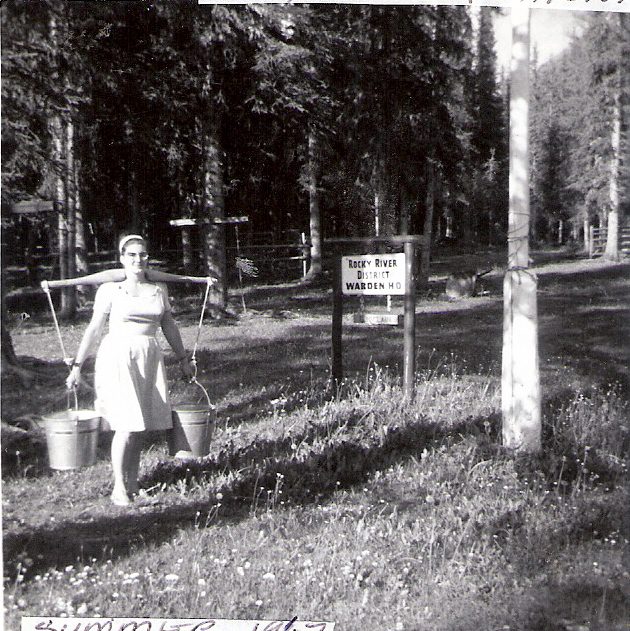
Sandra hauling water using a wooden yoke.
The only way to pack water in the backcountry!
Did you find it lonely?
(0:45:08) No I didn’t. Of course being an only child too, I wasn’t used to having a lot of people around growing up on a farm. No it didn’t bother me at all. When we went out to Jacques Lake for the winter, we came out at Christmas time and then I didn’t come out again until the spring. Gordon would go to town once a month and get extra groceries or whatnot. And that was it.
Was a day in town one that you looked forward to?
(0:46:00) It wasn’t anything really extra. It was just a thing that you did. Maybe get some different food and things. I soon learned after that first summer to do a lot of my own canning…I canned everything under the sun. When it came to meat, I canned hamburgers, I canned pork chops, I canned ribs, everything, chickens. Just about anything so that we always had halfway decent meat. That first summer was an eye opener…The canning was all in boiling water baths with the old type canners.
That would be a lot of work.
Oh yeah! And it was on a wood stove. They weren’t nice big wood stoves like on my farm where you could have a reservoir with hot water on it all the time. These were smaller stoves and they just weren’t as efficient as the bigger old wood stoves. But you made do! Packing water and all this wasn’t anything new because I had done it all my life. And the wood, getting the wood in and all that. Although that was the kids job.
Did they enjoy the backcountry life?
(0:48:15) Oh yeah, although the girls were pretty small. Mony was old enough to enjoy it and he liked to go with his dad. He was seven then. They would go out and spend days on horseback. But the girls, they don’t remember much of it. Shawna was just a baby and even when we were out at Snaring in Jasper there, they just remember some of it, but not a heck of a lot.
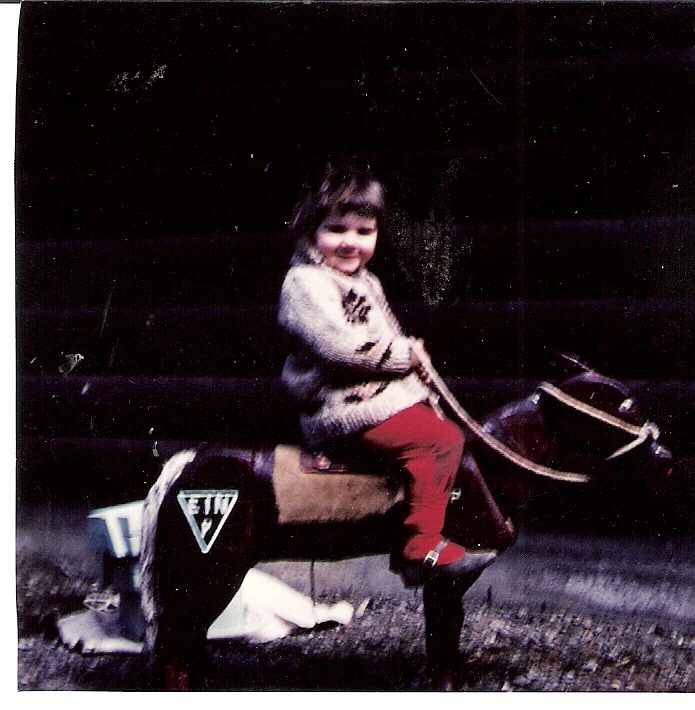
Shawna McClain 1968 on wooden horse carved by warden Andy Anderson
Note: Warden Andy Anderson carved, “Packy” in the early 1960s. This wooden horse had a long and nomadic life. He would appear and disappear at various wardens schools. The idea was to see which Park could steal it and put their brand on it. In, 1968, Jim White and Gordon McClain got it for Jasper. Some say that Packy was last seen in 1984, under the arm of a Yoho warden. Burns, R.J. and Schintz M. Guardians of the Wild (Calgary: University of Calgary Press, 2000), 317.
